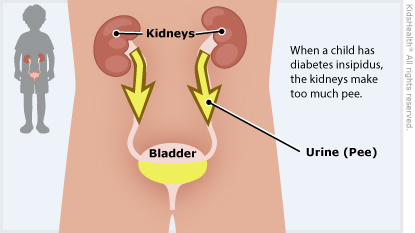In central diabetes insipidus, the body makes too much pee because it doesn't produce enough of a hormone called antidiuretic hormone (ADH). Kids with central diabetes insipidus (in-SIP-uh-dus) feel very thirsty and drink lots of liquids to replace the fluids they lose from peeing.
Medicine can replace the missing ADH and help the body make normal amounts of pee.
Use these instructions to care for your child at home.



Your child:

Your child:

What causes central diabetes insipidus? The cause of diabetes insipidus isn't always known. It can happen because of a tumor, trauma, or a problem that happens during surgery.
Is central diabetes insipidus the same as diabetes mellitus? No. Diabetes mellitus (sugar diabetes) includes type 1 diabetes and type 2 diabetes. Diabetes mellitus and diabetes insipidus both make children pee often and get thirsty easily. But children with type 1 or type 2 diabetes have high blood sugar. Children with diabetes insipidus have normal blood sugar levels.